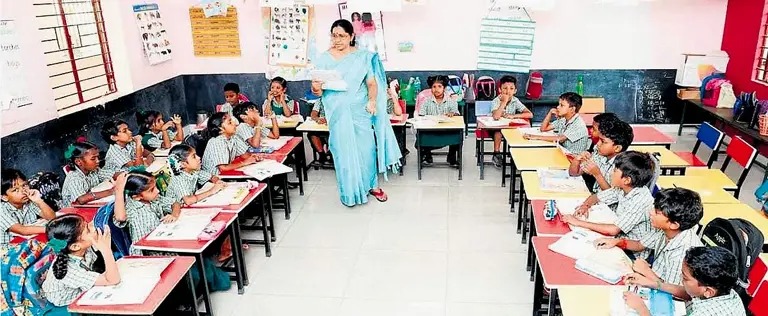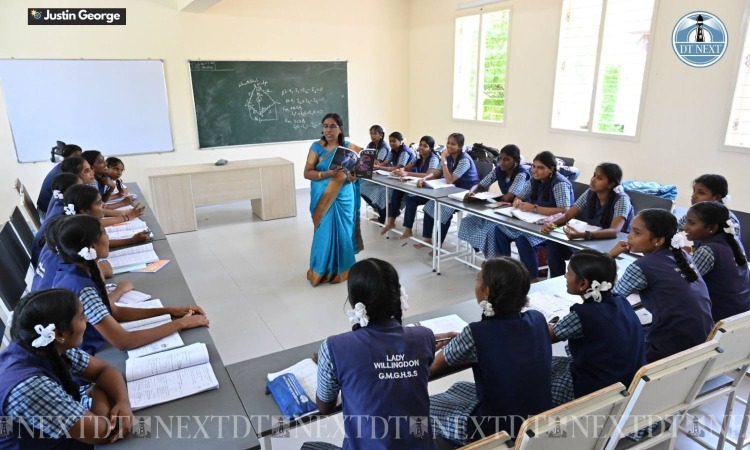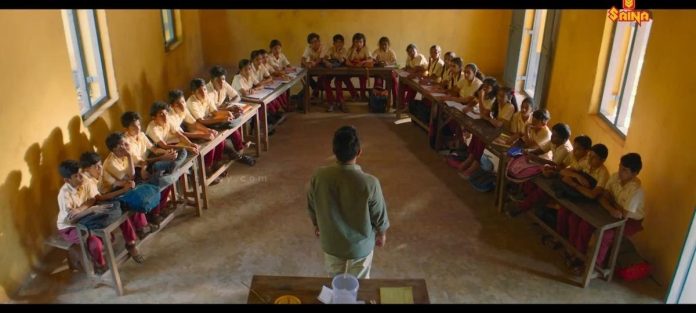– Atoofa Nasiha
The seating arrangement motive, who sparked the idea?
It all began with a Malayalam film, “Sthanarthi Sreekuttan” which promoted a new way of seating in classrooms, a semi-circular setup that was later embraced by educational institutions in Kerala. The idea quickly caught the attention of the Tamil Nadu government calling it Pa (ப) as the seating setup looks like the Tamil word ப and inspired by this approach, a circular was passed encouraging similar seating in schools. It wasn’t long before media outlets picked up on the change, praising the visual shift and the attempt to break away from the age-old concept of front-benchers and back-benchers. (New Indian Express)
 The model was adopted with the belief that it would encourage inclusivity and improve student participation. It travelled from classrooms in Kerala to those in Tamil Nadu, and soon turned into a trend. Yet, with all the buzz it created, the core of the issue started to reveal itself, the practical challenges were too many to ignore. Schools that tried this model found that it could only be adapted in classrooms with fewer students. Those sitting at the ends of the semi-circle were forced to keep their necks turned for long hours, straining their posture and concentration. In larger classrooms, the space in the middle remained empty and underutilised, making it a visually impressive but functionally questionable setup. (New Indian Express, The Federal, Times of India)
The model was adopted with the belief that it would encourage inclusivity and improve student participation. It travelled from classrooms in Kerala to those in Tamil Nadu, and soon turned into a trend. Yet, with all the buzz it created, the core of the issue started to reveal itself, the practical challenges were too many to ignore. Schools that tried this model found that it could only be adapted in classrooms with fewer students. Those sitting at the ends of the semi-circle were forced to keep their necks turned for long hours, straining their posture and concentration. In larger classrooms, the space in the middle remained empty and underutilised, making it a visually impressive but functionally questionable setup. (New Indian Express, The Federal, Times of India)
But let’s pause here and ask:
Is seating arrangement really the issue?
 Is it truly a method to improve students’ concentration and performance? Before we begin debating designs and layouts, we must acknowledge one simple truth: no seating arrangement alone can build a student’s confidence, attention span, or interest in studies. We are in a digital era filled with distractions and stimulation. Yet, we expect students to sit in the same room, on the same benches, with barely any breaks, for eight straight hours a day. With just 15-minute break in the morning and one hour for lunch, we are still, in many ways, running classrooms that belong to the 90s.
Is it truly a method to improve students’ concentration and performance? Before we begin debating designs and layouts, we must acknowledge one simple truth: no seating arrangement alone can build a student’s confidence, attention span, or interest in studies. We are in a digital era filled with distractions and stimulation. Yet, we expect students to sit in the same room, on the same benches, with barely any breaks, for eight straight hours a day. With just 15-minute break in the morning and one hour for lunch, we are still, in many ways, running classrooms that belong to the 90s.
The Backbench Stereotype
Now the debate has also shifted to removing the last bench entirely, assuming that students who sit there are inattentive, disinterested, or troublemakers. But this is a false generalisation. The term “backbenchers” was always more of a cultural tag than an academic reality. It became a trend to label last-bench students as the ones who goof around, but not all of them fit that stereotype. Some of the brightest minds have occupied the last bench, not out of rebellion, but by choice or circumstance.
So what could actually make a difference?
Before we rush to alter the arrangement of desks and chairs or repaint school walls in vibrant hues, it is crucial that we pause and reflect on what truly defines the strength of an education system.
When Kindness Made the Difference
Many students who sit in the back benches during their final years still manage to perform well. What truly influences their performance isn’t the seating arrangement but the presence of kind, understanding teachers – those who don’t yell or spark anxiety the moment they enter. Despite cramped desks and challenging environments, students try their best to focus, not because it’s easy, but because some teachers make learning feel meaningful. This reaffirms a simple truth: a good teacher really does shape a better student.
Over the years, our classrooms have seen both kinds of teachers, those who ignited minds and those who simply went through the motions. But it’s undeniable that a good teacher makes a remarkable difference in a child’s learning and character development. Their presence doesn’t just build academic growth but moulds the values, confidence, and outlook of a student. In a time when education is becoming more result-oriented than value-oriented, the need for teachers who inspire, mentor, and model integrity is more vital than ever.
Sadly, this isn’t what many students experience today.
Labelling and the Quiet Harm
There are toxic practices that have become so normalised we hardly question them. Students who do not perform well are often labelled as “weak students” or “slow learners.” Some teachers display blatant partiality. Toppers receive the spotlight, praise, and attention. Teachers often call on struggling students in front of the whole class, knowing they won’t answer, letting them sink into public embarrassment. That silence in the classroom is not a learning moment. It is a shame. And most parents don’t even know this happens.
While toppers deserve applause, the rest of the class shouldn’t be reduced to shadows. Schools must create spaces where students feel inspired by each other, not envious or humiliated. When you repeatedly label a student as weak, you are not encouraging them to grow, you are slowly convincing them they are incapable of growth and that is deeply unfair.
As someone once said, “Scolding a struggling student is like punishing a patient who is already sick.” Isn’t that heart-breaking?
The Obsession with Presentation
We often celebrate ideals like empathy, equality, and greatness through textbooks and speeches. But what about practising them? What about the child afraid to speak up in class? What about the student who dreads math, or can’t memorise a poem? Are they less worthy? No classroom renovation will matter if the environment inside is harsh, unkind, or biased.
Schools often obsess over their toppers, send them to competitions, feature them on banners with top percentages claiming, “This is what our school stands for.” Banners outside schools with photos of toppers might look impressive, but they create unhealthy hierarchies. They shift the focus from personal development to performance, from values to victory, and from growth to grades.
Producing Professionals Without a Moral Compass
We have produced professionals, yes. But many lack a moral compass. In today’s India, doctors are turning healthcare into a transaction. Engineers are constructing unsafe buildings. It’s not a lack of knowledge but It’s a lack of integrity. No one taught them that doing the job well isn’t enough if you’re doing it without ethics. Education that lacks values leads to real-life consequences such as corruption, moral failures, and loss of trust in every field.
The Changing Role of Teachers
Teaching once held a place of reverence as role models, as people who shaped not just students but the society itself. Today, that picture is fading. Teachers, even the passionate ones, are caught in a system that demands results over relationships. They are pressured to produce toppers. Their worth is measured not by the impact they make but by the number of names on a results board. In this race, teachers too begin pushing students hard, sometimes unconsciously contributing to an unhealthy obsession with ranks and marks.
What Are Classrooms Today?
Many classrooms have become mechanical spaces like a cycle of memorisation, repetition, and marks. The vibrancy, the joy, the ethics have faded. Students don’t relate to subjects as meaningful, exams are battles and learning becomes a burden. Where are the lessons on empathy, responsibility, and kindness? These are not optional but necessary. We need to bring back value education as seriously as math and science. Because without it, we raise students who are smart but selfish, capable but unethical.
Dr. Sarvepalli Radhakrishnan once said, “The destiny of the nation is shaped in its classrooms.” If that’s true, we must reform the classrooms first.
We must build character before credentials, purpose before performance and morals before milestones. We need to redeem education from becoming a business and reclaim it as a service. Schools must be places of learning, not revenue generation. And if you peel back the next layer of this school business, you’ll find the cost of education soaring without logic or balance.
The Commercialisation of Education
Now let’s see the bigger picture, one of the gravest problems we now face is the commercialisation of education. Learning has been reduced to a business model. Institutions operate like factories. Students are treated like clients. Teachers are evaluated through performance metrics and output targets. The dream of education has become expensive, exclusive, and exhausting. Parents are forced to bear unbearable fees in the hope that their children will secure a decent future.
The outcome? Education becomes a privilege, not a right. The purpose of learning becomes skewed. Instead of nurturing character, the focus is on cracking entrance tests, topping boards, and getting high packages. What about compassion? What about contributions?
How Have Private School Fees Changed?
A national survey conducted by LocalCircles between 2022 and 2025 reveals that 44 percent of parents reported fee hikes of 50-80 percent, while 8 percent reported increases exceeding 80 percent. The survey spanned 31,000 parents across 309 districts, capturing a broad cross-section of schooling experiences. (LocalCircles, Times of India)
In several major cities, including Bengaluru, Hyderabad, and Delhi, fee increases have ranged between 10 to 30 percent just for the single academic year 2025–26. (Times of India)
According to Crisil Ratings, the education sector is experiencing annual revenue growth of 12-14 percent, while education costs overall are climbing at about 8-10 percent per year which is far above typical consumer inflation, which remains around 5-6 percent. (Business Standard)
Why Are Fees Rising So Fast?
Schools commonly cite rising costs for infrastructure, teacher salaries, new facilities, and compliance-related expenses as reasons for frequent hikes. Modern schools increasingly offer luxury facilities such as air‑conditioned campuses, smart classrooms, and transport services. Yet regulators and parents argue that fee structures lack transparency. In states like Tamil Nadu and Maharashtra, some regulatory measures exist, but enforcement is weak.
Schools are often allowed to hike tuition by up to 10 percent every three years if requests are justified which left other ancillary charges unchecked. Haryana’s Directorate of Secondary Education recently issued warnings to schools after discovering that many had entered zero charges for development fees in mandatory fee disclosure forms which indicated possible concealment of actual fees charged.
Impact on Parents and Middle-Class Families
With incomes from 2021-22 to 2022-23 rising modestly (around 10 percent), such fee hikes place disproportionate pressure on middle-class families – which is a phenomenon some experts call the “silent killer” of India’s middle class. (Scroll.in)
In Telangana, parent advocacy groups report schools doubling fees every year, even withdrawing students who simply can’t keep up financially. Families have shifted children to government schools as a result. (The Hindu)
In Madurai, even privately run CBSE and matriculation schools are pushing overall annual bills to ₹70,000 to ₹1 lakh, including tuition, transport, uniforms, and activity charges – which forces parents to rethink affordability. (Times of India)
Fee Timeline: A Snapshot
| Time Period | Reported Increase | Implications |
| Last 3 years (2022–25) regions | 50–80% (44 %)<br>Above 80% (8 %) | Steep rises across |
| 2025–26 academic year pressure | 10–30 % in many cities | Single-year hikes adding |
| Annual sector growth burden | 12–14% revenue, 8–10% fees | Outpaces inflation, inflates |
| Fee range by city generally steep | ₹1 lakh–₹4 lakh (Tier 1/2)<br>₹50,000–₹2 lakh (Tier ¾) | Wide but generally steep
|
Sources and References: These statistics are compiled from Reports by Economic Times, Hindustan Times, and Business Standard, Findings from National Independent Schools Alliance (NISA), and Survey results shared in LocalCircles and regional parent associations (2023-25).
Over the past 20 to 25 years, school fees have surged from as low as ₹100 a month to ₹30,000 or more, revealing a clear shift in priorities and the growing commercialisation of education. This steep rise places an immense burden on middle-class families and raises urgent questions about affordability, fairness, and the true purpose of schooling. And that’s just the cost for one child. How is a family expected to manage when nearly 90 percent of their income goes toward school fees alone? What remains for essentials like food, rent, or savings? To make matters worse, parents are not only paying for education but are also charged for air conditioners, smartboards, and flashy infrastructure. But are these the things children really need to learn, grow, and thrive?
Education is a right. It should be affordable. It should be accessible. No parent should have to sacrifice their entire salary to ensure their child gets a decent, deserving education. If things go on this way, more families will eventually shift to home schooling. And that will not be a sign of progress, but of the system’s failure.
So before we rush to alter the arrangement of desks and chairs, let us fix the foundation.
Let’s rethink our priorities.
Let’s stop praising infrastructure while ignoring the cracks in our values.
Let’s redefine education to nurture minds and morals, not just produce ranks.
Let’s welcome teachers who inspire, not just instruct.
Let’s ease the burden of high fees on striving parents.
Let’s judge students by their effort and growth, not where they sit.
Let’s make learning about compassion, accessibility and real progress.
Let the focus shift from furniture to the future of our children.
Only then will we create classrooms that truly form a better future.




